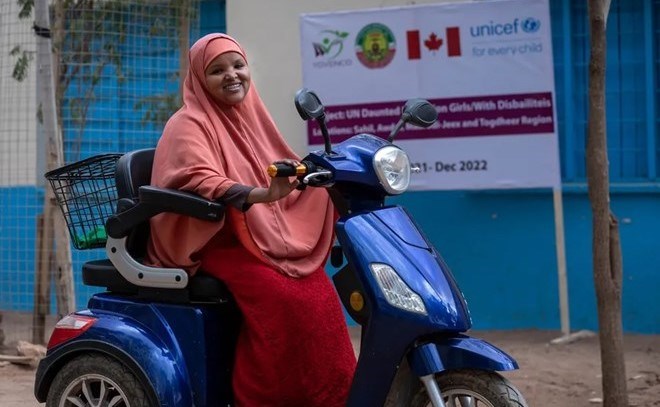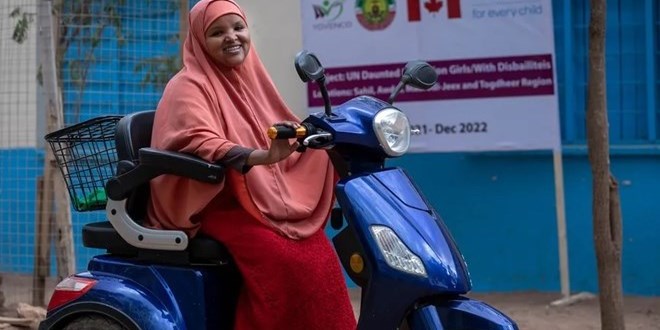[ad_1]
By Abdinasir Ali Mohamed
Wednesday March 20, 2024

Children in Somalia face significant challenges in accessing basic education. The majority who manage to receive some form of education represent only a small fraction of the able-bodied student population in urban centres. Meanwhile, disabled children, regardless of gender, often find themselves left out, their potential untapped, except for the rare cases where their families have both the awareness of the importance of education and the necessary social connections.
Yet, beneath these broad challenges lies a deeper, more silent crisis, one that barely whispers in the noise of societal neglect—girls with mobility disabilities. They are the forgotten within the forgotten, invisibly struggling at the intersection of disability and gender. Their daily reality is a testament to a ‘silent double crisis’ where their very existence is erased or often overlooked, and their needs are pushed to the side-lines of societal concern. Affected by both their disability and their gender, these girls face a dual form of marginalization that is both heart-breaking and unjust. This is the silent cry that goes unheard, the plight that remains unseen, as these girls, deserving of dignity and opportunity, continue to be eclipsed by the shadows of indifference. This short piece highlights the daily struggles of girls living with mobility disabilities who have become virtually invisible in our society.
Every day, girls with mobility disabilities, both in urban and rural areas, strive to overcome physical limitations and navigate their surroundings amidst the harsh realities of scorching heat on dusty streets, surrounded by people who do not want to see them at all. Their stark realities call for a portrayal that highlights the challenges and barriers that diminish their humanity and render them invisible. Their situation represents not just neglect, but a profound oversight, where the intersection of gender and disability renders them virtually invisible.
While people with mobility disabilities face overwhelming challenges in their daily lives, girls with mobility disabilities face double disadvantages. Society’s attitudes and their tendencies to ignore and overlook the disabled, and the pervasive gender biases further disadvantage girls by prioritizing the needs and visibility of boys. From personal experience, I recall seeing boys with varying forms of disabilities, such as those crawling, others in wheelchairs or using wooden crutches coming to school, but I had never seen any disabled girls, not even one in a wheelchair come to school during my primary and secondary school days. The problem is the same in higher education and in most private and public institutions.
The difference is so glaring. Boys with limited mobility, despite their challenges, have a presence in public life, albeit small. They attend schools, engage in higher education, and some have excelled in professional careers. They are recognized, acknowledged, and, to some extent, accommodated. Conversely, girls with similar disabilities are conspicuously absent. They are the unseen group, lacking not only visibility but also the opportunities that could help them move from the side-lines to the centre and the forefront.
This contrast became apparent to me during my time at ILAYS ACADEMY. Over the course of more than eleven years, I have witnessed numerous boys with various mobility disabilities come through our doors, each with their own unique story of resilience and struggle. However, despite adapting our school facilities to accommodate learners with mobility challenges, I have not encountered a single girl with a mobility disability during this time. This undeniable fact has prompted me to reflect on the systemic barriers that render these girls invisible, preventing them from accessing vital life-sustaining opportunities. The absence of girls with mobility disabilities in education and society is not merely a reflection of societal neglect; it represents a profound loss not only for the girls themselves but also for their families, communities, and our entire nation. Each girl absent from the classroom, every young woman excluded from educational opportunities, holds untapped potential that could significantly contribute to our collective societal progress.
Just a few weeks back, a short video clip took social media by storm, featuring a young girl navigating her way through the dirt under the unforgiving glare of the sun, right in front of shops, businesses, and the indifferent gazes of passers-by. That image moved me to tears. It wasn’t just the sight of her struggle that got to me, but the palpable absence of empathy from those who witness her daily plight first-hand on that very street. I couldn’t help but imagine the person she might become with the right support, the dreams she could chase, and the immense potential waiting to be unlocked. It also made me introspective, considering my own ease of movement, something I’ve admittedly taken for granted. It highlighted a shared humanity between us, seen equally in the eyes of our creator. This moment was a wake-up call, reminding me of my own bubble within the school walls where I work and live, somewhat shielded from the harsh realities faced by girls like her every day outside of our school gate.
That day, seeing the girl’s journey across the sand, felt like a direct challenge to my conscience: would I just stand by, or would I act? It’s easy to get lost in the notion that we should stick to our own lanes, but the heart has its own logic, urging us to reach out, to make a difference where we can, pushing us to step beyond the usual confines of self-interest. Fortunately, after a short search, we managed to find the girl’s family, living about six kilometres from our school, and offered the young girl a full scholarship. Now, she’s part of the ILAYS ACADEMY family. From our perspective, it is a small act of kindness. However, for this one girl, it’s the beginning of a whole new world of opportunities.
Now, let’s take a moment to reflect. Imagine ourselves in that position, if only for a moment, dragging ourselves through the sand just to reach the shops, the hospital, the mosque, the market and home. Now, think of the thousands of girls who live this reality every day of their lives! Isn’t it of utmost importance and urgency that we re-evaluate our ways of thinking and completely reassess our attitudes towards these girls living with mobility disabilities, and the priorities that govern our society?
Schools, universities, private businesses, and public institutions—all sectors of society—must recognize the unique struggles faced by girls with mobility disabilities and implement substantial measures to address their plight which is also our plight. While the challenge of accessing basic education for all children in Somalia is the responsibility of the government, both at the centre and at the regional level, given the current state of affairs in our country, it becomes the duty of every able member of society to actively seek out, acknowledge and support the disabled girls in their neighbourhood. These young girls, who often go unnoticed and unheard, deserve our attention and support to create a more inclusive and equitable society. This is not just about acts of kindness; it is about supporting our weakest and most disadvantaged members, fostering empathy and compassion, and empowering disabled girls in their daily lives. We must teach our children and our communities to ensure that no disabled girl is left to crawl in the dirt unnoticed, while our own abled-bodied ones attend schools in bright uniforms.
In wrapping up, let’s not lose sight of the real faces at the heart of this discussion: the girls with mobility disabilities in our communities. They are more than their challenges, with dreams, talents, and the right to be part of our world, just like everyone else. These girls are our daughters, not aliens!
Remember the young girl we welcomed into ILAYS ACADEMY? Her story is a rallying cry for all of us. We have the power to alter the course of these girls’ lives, one step at a time. It’s time to broaden our hearts and open our school doors even wider. Let’s ensure that no child, especially no girl, is forced to crawl, dragging herself through the dirt, living in the shadows, or feeling overlooked right before our very eyes.
The change starts with us, in our neighbourhoods, through our actions and our empathy. Together, we can illuminate the unseen and reassure them they’re not alone. This is the kind of community I believe in and aspire to create. At ILAYS ACADEMY, we have initiated this change for her, but the enduring question remains: will you open your eyes to this reality and extend this change to all girls like her, reaching as far as you can?
[ad_2]
